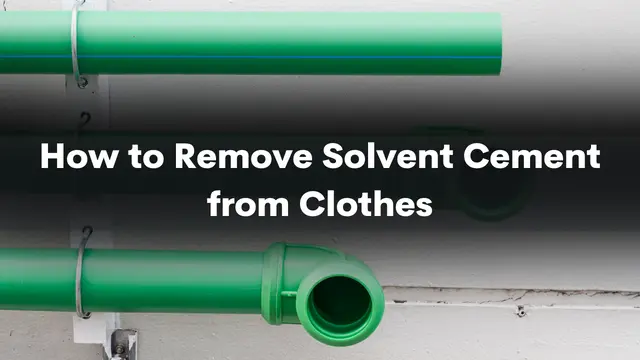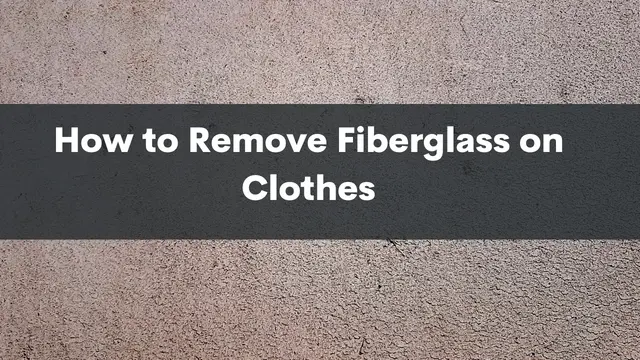Hey there! Have you ever found yourself in a sticky situation with Flex Seal on your favorite clothes? Don’t worry, we’ve got you covered!
In this comprehensive guide, we’ll walk you through the process of safely and effectively removing Flex Seal from clothes. Whether it’s an accidental spill or a DIY mishap, we’ll help you rescue your beloved garments and restore them to their former glory.
Contents
Understanding Flex Seal
Before we dive into the removal process, let’s take a moment to understand what Flex Seal is and why it can be quite the challenge to remove from clothes.
Flex Seal is a popular adhesive sealant known for its ability to create a waterproof barrier. While it works wonders for sealing cracks and leaks, it can be a real nuisance when it accidentally ends up on your clothes.
The trouble with Flex Seal lies in its strong adhesion and durable nature. Once it dries, it can become stubborn and cling to fabrics, making removal a daunting task.
Attempting to remove it improperly can potentially damage the fabric further, leaving behind unsightly residue or even ruining the garment altogether. That’s why it’s crucial to follow the right techniques and use the appropriate tools to ensure successful removal without causing harm.
Preparing for Flex Seal Removal
Now, let’s get prepared to tackle the task of removing Flex Seal from your clothes.
Before you jump into the removal process, it’s important to assess the fabric and the condition of the Flex Seal stain.
Different fabrics may require different approaches, and the severity of the stain may affect the removal method you choose.
To get started, gather the necessary materials and tools.
You’ll need a few items on hand to make the removal process smoother and more effective.
Some of the common materials include scraping tools like a plastic spatula or a blunt knife, solvents such as acetone or rubbing alcohol (avoid using acetone on delicate fabrics like silk or rayon), mineral spirits (suitable for delicate fabrics), clean white cloths, and a gentle detergent for laundering the clothes later.
Before you begin the removal process, it’s essential to take some precautions. Make sure you’re working in a well-ventilated area to avoid inhaling any fumes from the solvents. If you’re using solvents like acetone, remember that it can be harsh on certain fabrics, so do a spot test on a discreet area of the fabric to check for any adverse reactions.
For delicate fabrics like silk or rayon, consider using mineral spirits instead.
With everything prepared and precautions in place, you’re now ready to embark on the journey of removing Flex Seal from your clothes. So, let’s roll up our sleeves and get those garments back in tip-top shape!
Step-by-Step Guide to Remove Flex Seal from Clothes
Step 1: Scraping off Excess Flex Seal
Now that you’re ready to begin the removal process, the first step is to scrape off any excess Flex Seal from the fabric.
Grab a plastic spatula or a blunt knife and gently scrape the surface of the fabric where the Flex Seal is located. Be careful not to apply too much pressure to avoid spreading the sealant further or damaging the fabric.
Start by scraping off as much of the dried Flex Seal as possible. Work slowly and methodically, applying gentle strokes to lift the sealant off the fabric. If the Flex Seal has formed a thick layer, you may need to break it into smaller pieces to make it easier to remove.
Remember, the goal here is to remove the excess Flex Seal without pushing it deeper into the fabric fibers. Take your time and be patient. Once you’ve successfully scraped off as much as you can, proceed to the next step.
Step 2: Applying an Appropriate Solvent
Depending on the fabric type and the severity of the stain, you’ll need to choose an appropriate solvent to help dissolve and loosen the Flex Seal.
One commonly used solvent for this purpose is acetone.
It’s effective in breaking down the adhesion of Flex Seal without causing significant damage to most fabrics.
However, it’s crucial to note that acetone can be harsh on certain delicate fabrics, such as silk or rayon. If you’re uncertain about using acetone, consider opting for an alternative like rubbing alcohol or mineral spirits, especially for delicate fabrics.
To apply the solvent, dampen a clean white cloth with a small amount of acetone or rubbing alcohol. Gently dab the cloth onto the Flex Seal stain, making sure to cover the entire affected area. Avoid rubbing or scrubbing vigorously, as this can push the Flex Seal deeper into the fabric or spread it around.
Allow the solvent to penetrate the Flex Seal for a few minutes. This will help loosen the sealant and make it easier to remove. However, be mindful of the fabric’s sensitivity to the solvent and avoid leaving it on for too long to prevent any potential damage.
Step 3: Gentle Scrubbing and Rinsing
After allowing the solvent to work its magic, it’s time to gently scrub the Flex Seal stain.
Take a soft-bristled brush or an old toothbrush and lightly scrub the stained area in circular motions. This will help break down the remaining sealant and lift it off the fabric.
Remember to be gentle while scrubbing to avoid damaging the fabric fibers. If you encounter any resistance, don’t force it. Instead, apply a bit more solvent and continue gently scrubbing until the Flex Seal starts to come off.
Once you’ve removed the majority of the stain, rinse the fabric under cool running water. This will help wash away any loosened Flex Seal particles and residue. Hold the fabric under the running water, allowing it to flow over the stained area. Continue rinsing until the water runs clear and no more Flex Seal remnants are visible.
Make sure to check the fabric after rinsing to see if any traces of Flex Seal remain. If there are still stubborn spots, repeat the solvent application and gentle scrubbing process until the fabric is completely free of Flex Seal.
Step 4: Repeating the Process if Necessary
In some cases, particularly with older or more stubborn Flex Seal stains, you may need to repeat the solvent application and scrubbing process multiple times to achieve optimal results. Don’t get discouraged if the stain doesn’t disappear entirely after the first attempt.
If the stain persists, apply the solvent again, let it sit for a few minutes, and gently scrub the area.
Remember to rinse the fabric thoroughly between each attempt to assess the progress and determine whether additional removal steps are required.
Step 5: Laundering and Inspecting the Clothes
Once you’ve successfully removed the Flex Seal stain, it’s time to launder the clothes as you normally would. Follow the washing instructions specific to the fabric type and use a gentle detergent. This will ensure that any remaining solvent or Flex Seal residue is completely eliminated.
After laundering, inspect the fabric to ensure that the stain is gone. Check for any signs of damage or discoloration caused by the removal process. If there are no visible remnants of Flex Seal and the fabric appears to be in good condition, congratulations! You’ve successfully removed Flex Seal from your clothes.
However, if you notice any lingering residue or if the fabric has sustained damage during the removal process, don’t worry. In the next section, we’ll provide you with additional tips and considerations to address such situations and offer preventative measures to avoid future mishaps.
Additional Tips and Considerations
Dealing with Stubborn or Older Flex Seal Stains: While the previous steps should effectively remove most Flex Seal stains, there may be instances where the stain is particularly stubborn or has been on the fabric for an extended period. In such cases, additional measures can help tackle the problem:
Soaking Method: For persistent stains, you can try soaking the affected area in a solution of warm water and gentle detergent. Let the fabric soak for a few hours or overnight before proceeding with the removal steps outlined earlier. This soaking process can help further loosen the Flex Seal and make it easier to remove.
Repeated Application: If the stain remains despite your initial efforts, consider repeating the solvent application and gentle scrubbing process multiple times. Patience and persistence can be key to removing stubborn Flex Seal stains.
Seeking Professional Help:
In some situations, it may be best to seek professional assistance, especially if the fabric is delicate or valuable. Professional dry cleaners have expertise in handling various stains and fabrics, and they can employ specialized techniques to remove Flex Seal effectively while minimizing the risk of damage.
When opting for professional help, make sure to inform the cleaners about the nature of the stain and the fabric type, as this will help them determine the best course of action.
Preventative Measures to Avoid Flex Seal Mishaps:
Prevention is always better than dealing with the aftermath of a Flex Seal mishap. Here are some preventative measures to keep in mind:
Protective Gear: When using Flex Seal, especially in projects involving fabrics, consider wearing protective gloves and aprons to prevent accidental spills and stains on your clothes.
Work in a Controlled Environment: Perform Flex Seal projects in a well-ventilated and designated area, preferably away from your clothing or any valuable fabrics. Creating a controlled environment minimizes the risk of accidental spills or splatters.
Cover and Mask: If you’re working near fabrics or clothing, cover them with plastic sheets, drop cloths, or old newspapers to provide a barrier of protection against potential Flex Seal drips or sprays. Masking off the area can prevent unwanted contact with the sealant.
Practice Precision: Take your time and exercise caution when applying Flex Seal. By practicing precision, you can reduce the likelihood of spills or splatters that may end up on your clothes.
Read the Instructions: Familiarize yourself with the instructions provided by the manufacturer of Flex Seal. Following the recommended guidelines for application, curing time, and cleanup will help minimize the chances of accidents and subsequent stains.
FAQs
Can I use nail polish remover to remove Flex Seal from clothes?
Nail polish remover typically contains acetone, which can be effective in removing Flex Seal. However, it’s important to check the fabric’s compatibility with acetone before using it. Perform a spot test on an inconspicuous area of the fabric to ensure it doesn’t cause any damage or discoloration.
Will rubbing alcohol damage my clothes when removing Flex Seal?
Rubbing alcohol is generally considered safe for most fabrics when used in moderation. However, it’s always recommended to perform a spot test before applying it to the stained area. Some delicate fabrics may be sensitive to rubbing alcohol, so it’s essential to exercise caution and proceed with care.
Can I remove Flex Seal from dry-clean-only garments?
Removing Flex Seal from dry-clean-only garments can be tricky, as solvents and scrubbing may not be suitable for these fabrics. In such cases, it’s best to take the garment to a professional dry cleaner and inform them about the Flex Seal stain. They will have the expertise to handle the stain effectively without compromising the fabric’s integrity.
What if I accidentally washed my clothes with Flex Seal on them?
If you’ve already washed your clothes with Flex Seal on them, it’s likely that the sealant has adhered more firmly to the fabric. In such cases, it’s recommended to repeat the removal steps outlined in the guide, paying extra attention to thorough solvent application and gentle scrubbing. You may need to repeat the process several times to achieve the desired results.
How can I prevent Flex Seal from getting on my clothes in the first place?
Prevention is key! To avoid getting Flex Seal on your clothes, consider wearing protective gloves and aprons when working with the sealant. Additionally, cover the surrounding area with plastic sheets or drop cloths to create a barrier of protection. Taking these precautions will minimize the risk of accidental spills or splatters.
Can I remove Flex Seal from delicate fabrics like silk or satin?
Delicate fabrics like silk or satin require extra care when dealing with stains. It’s crucial to consult a professional dry cleaner if you have Flex Seal on delicate fabrics, as they have the expertise to handle such materials without causing damage. Attempting to remove Flex Seal from delicate fabrics yourself may lead to irreversible damage or discoloration.
Parting Shot
Remember, patience and a gentle approach are key to successful removal.
If a stain proves challenging to remove, don’t hesitate to seek professional help to prevent any further damage to your cherished garments.
We hope this guide has been informative and helpful. Happy stain removal!




